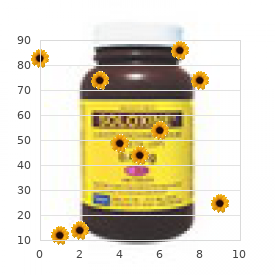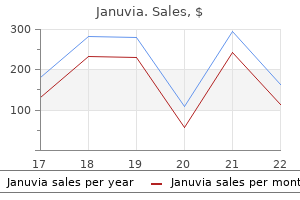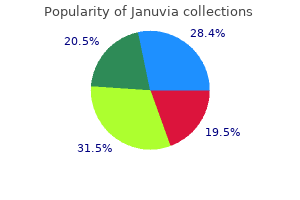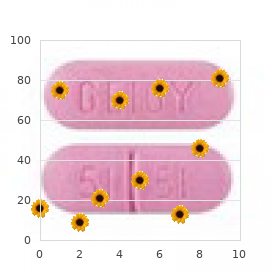
Januvia
| Contato
Página Inicial

"100 mg januvia, diabetic watch".
J. Fasim, M.A.S., M.D.
Associate Professor, Rocky Vista University College of Osteopathic Medicine
The topic is in the supine place diabetes type 1 online test cheap januvia 100 mg overnight delivery, activity diabetes symptoms shivering januvia 100 mg cheap with amex, which represents the resting discharge with his head elevated 30� to bring the horizontal described above blood glucose procedure januvia 100 mg discount visa. The chilly caloric inputs from the two ears generates vestibular nysirrigation cools the endolymph in part of the tagmus if the imbalance is prolonged diabetes diet.org januvia 100 mg order without a prescription. This cooled endolymph turns into rotational stimuli the surrounding endolymph slightly denser thanunbalance the vestibular input via thus falls, causing the action of the semicirand the normal transducereyes to rotate towards cular canals. This vestibular eye motion or disease causes a pathologic imbalance fast is repeatedly interrupted by a compensatoryby eliminating or movement in the other way. Therefore, the same mechanism A chilly caloric nystagmus is thus created, with its slow phasethe pure its fast section away from to produces towards and physiological response the irrigated ear. An experimental research of the acoustic impedfrom theof the middle ear andvestibular nystagmus if ance 2 ears generates its transmission properties. The 4-50 the mechanism of cold the endolymph is the density causing it to fall,portion of the endolymph is elevated, of the cooled thereby producing endolymph increased, causing sluggish section of the caloric nystagmus is in movement. Theof endolymphof the caloric nystagmus is in the direction of endolymph movement. Vowel intelligibility in the absence of the acoustic reflex: performance-intensity traits. Comparison of ear-canal reflectance and umbo velocity in sufferers with conductive listening to loss: a preliminary examine. Sound-conduction effects on distortion-product otoacoustic emission screening outcomes in newborn infants: check performance of wideband acoustic switch functions and 1-kHz tympanometry. Wideband reflectance in newborns: normative areas and relationship to hearing-screening outcomes. The fine construction of freeze-fractured intercellular junctions within the guinea pig inside ear. Ontogeny of structures and function within the vertebrate auditory system In: Jacobson M, ed. The responses of hair cells to low frequency tones and their relationship to the extracellular receptor potentials and sound stress degree in the guinea pig cochlea In: Syka J, Aitkin L, eds. Immunohistochemical localization of several cytoskeletal proteins in inside ear sensory and supporting cells. Distribution and polarity of actin within the sensory hair cells of the chinchilla cochlea. They are exquisitely sensitive transducers that in human beings mediate the senses of hearing and balance. A tiny pressure applied to the highest of the cell produces an electrical signal at the backside. Mechano-electrical transducer currents in hair cells of the classy neonatal mouse cochlea. The transduction channel of hair cells from the bull-frog characterised by noise analysis. The tip-link antigen, a protein related to the transduction advanced of sensory hair cells, is protocadherin-15. Structure of a force-conveying cadherin bond essential for inner-ear mechanotransduction. The space-time sample of the cochlear microphonic (guinea pig) as recorded by differential electrodes. Are inner or outer hair cells the supply of summating potentials recorded from the round window. Phosphorothioate oligodeoxynucleotides can selectively alter neuronal activity within the cochlea. Changes in endolymphatic potential and crossed olivocochlear bundle stimulation alter cochlear mechanics. The impact of noise publicity on the details of distortion product otoacoustic emissions in people. Nature of the motor factor in electrokinetic shape modifications of cochlear outer hair cells. Prestin is required for electromotility of the outer hair cell and for the cochlear amplifier. Intracellular anions because the voltage sensor of prestin, the outer hair cell motor protein. Prestin-based outer hair cell motility is important for mammalian cochlear amplification. Putting ion channels to work: mechanoelectrical transduction, adaptation, and amplification by hair cells. Use of otoacoustic emissions to discover the medial olivocochlear system in people. Contralateral suppression of otoacoustic emissions: An index of the operate of the medial olivo-cochlear system. An estimate of the prevalence of tinnitus caused by spontaneous otoacoustic emissions. Distortion-product otoacoustic emissions and cochlear microphonics: relationships in sufferers with and with out endolymphatic hydrops. The sharpening of cochlear frequency selectivity in the normal and irregular cochlea. The frequency response and different properties of single fibers in the guinea-pig cochlear nerve. Time construction of discharges in single auditory nerve fibers of the squirrel monkey in response to advanced periodic sounds. Phase-locked response to low-frequency tones in single auditory nerve fibers of the squirrel monkey. Encoding of steady-state vowels within the auditory nerve: representation when it comes to discharge fee. The dynamic range downside: Place and time coding on the stage of the cochlear nerve and nucleus In: Syka J, Aitkin L, eds. On the peripheral coding of the extent of particular person frequency components of complex sound levels. Representation of steady-state vowels within the temporal features of the discharge patterns of populations of auditory-nerve fibers. Effects of signal degree and background noise on spectral representations in the auditory nerve of the home cat. Spatial group of the auditory nerve based on spontaneous discharge price. Electronmicroscopic research of the efferent and afferent innervation of the organ of Corti in the cat. Alpha 9: an acetylcholine receptor with novel pharmacological properties expressed in rat cochlear hair cells. Effects of crossed-olivocochlear-bundle stimulation on cat auditory nerve fiber responses to tones. Their graphic reconstruction in cochleae by localization of acetyl-cholinesterase exercise. Nonlinear mechanical behaviour of the basilar membrane within the basal turn of the guinea pig cochlea. Application of a commercially-manufactured Doppler-shift laser velocimeter to the measurement of basilar-membrane vibration. Auditory frequency selectivity and the cochlear nerve In: Zwicker E, Terhardt E, eds. Effect of electrical stimulation of the crossed olivocochlear bundle on auditory nerve response to tones in noise. The impact of acoustic trauma on the tectorial membrane, stereocilia, and listening to sensitivity: attainable mechanisms underlying harm, restoration, and protection. Altered susceptibility of 2f1-f2 acoustic-distortion merchandise to the results of repeated noise publicity in rabbits. The impact of repeated day by day noise exposure on sound-conditioned and unconditioned guinea pigs. Frequency-dependent self-induced bias of the basilar membrane and its potential for controlling sensitivity and tuning in the mammalian cochlea. Response of binaural neurons of dog superior olivary complex to dichotic tonal stimuli: some physiological mechanisms of sound localization.


The combined crossed and uncrossed fibers journey within the vestibular nerve and cross into the cochlear nerve by way of the vestibulocochlear anastomosis diabetes mellitus life expectancy januvia 100 mg order with amex. However blood glucose 435 discount januvia 100 mg online, the hypothesis that the olivocochlear system primarily supplies some kind of input gating mechanism is probably not utterly appropriate blood glucose greater than 400 cheap 100 mg januvia with visa. One intriguing line of current research on the traumatic results of noise publicity is the notion of "training" the cochlea to turn out to be much less susceptible to damaging sounds diabetes blood test 100 mg januvia order. Introduction to the Central Auditory Pathway Each of the five major senses sends information into the brain by way of two separate pathways: a direct or particular pathway and a nonspecific pathway. The nonspecific pathway entails buildings in the core of the neuraxis, collectively known as the reticular system. In the reticular system, all sensory modalities share the identical gross neural structures (hence the name nonspecific). Ascent by way of the nonspecific buildings is multisynaptic and hence is characterised by long delay times. The direct pathways for every sensory modality are separate and contain lengthy axonal processes, with a minimal variety of synapses; consequently, compared with the indirect pathway, transmission alongside the direct pathways entails minimal delay times. The synapses of the direct pathways tend to congregate in well-defined neural buildings known as nuclei. Clinically, lesions of the central auditory system are localized according to their level within the direct projection pathway. The numbers in every nucleus indicate neuronal order (determined by the variety of synapses). The auditory projection pathway is extra complex than the pathways of different sensory systems, probably because it developed relatively late on the phylogenetic scale and needed to incorporate pieces of other already developed neuronal systems. Other techniques make use of such labels as lipophilic dyes (eg, dilinoleyl-tetramethylindocarbocyanine or Dil), which could be retrogradely transported in fastened tissue by diffusion. Visualization of the location of cellular projections or the cellular/subcellular location of labeled substances on the mild and electron microscope ranges is achieved both by autoradiography, within the case of radioactive compounds, or by catalyzation of histochemical reactions, that are sometimes considered underneath epifluorescence or darkfield optics. With recent refinement of those tract tracing and cell component-labeling techniques utilizing immunohistochemical markers, just about all projection pathways and cell types of the auditory system have been described. Lagging far behind our description of the connections of the neural pathway for hearing is our understanding of how this community of interconnections interacts to produce our advanced auditory sensations. Presented beneath is a short description of the main projections of the auditory pathway adequate for the clinician to perceive the transfer of information within the auditory system, without consideration of the numerous lesser connections revealed by fashionable immunocytochemical staining methods. The reader is referred to a quantity of comprehensive reviews that provide extra details of the intricate interconnections of the central auditory system. Numbers indicate the approximate neuron order as decided by the variety of synapses traversed. Dashed traces labeled with query marks indicate two areas of uncertainty: 1) whether the dorsal cochlear nucleus primarily contains second- or third-order neurons and 2) whether or not any nerve fibers bypass the inferior colliculus. The auditory projection pathway is extra complicated than the pathways of different sensory methods, probably as a outcome of it developed relatively late on the phylogenetic scale and the auditory portion of the eighth nerve bifurcates had to incorporate pieces of other already develinto two branches, one which sends fibers to synapse oped neuronal systems. For instance, usually, alongside any single penetration of a microelectrode trajectory within a principal nucleus, there are two or extra breaks in the orderly development of best frequencies. Thus, as within the direct projection pathways of all sensory techniques, multiple illustration of the receptor floor occurs. Numbers point out the approximate neuron order as their anatomic characteristics revealed by varied determined by the number of synapses traversed. These fiber tracts embrace the ventral- (trapezoid body), intermediate-, and dorsal-acoustic striae. This pathway additionally crosses the midline Bythe frequency depth area, someinputcells exhibit complex response patterns that describe to innervate the identical constructions on the contralat- an inhibitory ipsilateral enter (or vice versa), the Cochlear Nucleus. Fibers of theCentral processing ofstria, neurophysiologic behavior of theseproduced by a information carried in the auditory nerve begins explained. The poststimuresponselus timefound for fibers of the audipattern histograms had been obtained tory nerve. Cell varieties presumably associated with these response patterns from terns from prime to backside are pyramtop to backside octopus, globular, multipolar, idal, are pyramidal, octopus, globular, multipolar, and spherical. Purely excitatory responses as in A predominant within the anterovenare predominant in nucleus. Greaterare discovered quantities of inhibition quantities of inhibition the discovered toward the towards are dorsal cochlear dorsal cochlear nucleus (D and E). Question Question marks variable or uncermarks show show variable or uncertainfeatures. Thus, for any 1 ear, connections one hundred seventy five auditory projection pathway above the trapezoid body, there are models that are sensitive to binaural time and degree variations. Recently, these nuclei have acquired more consideration in makes an attempt to define their role in auditory processing. The predominant termination zone for the ascending auditory projections is within the ventrolateral region of the central nucleus. This nucleus can also be composed of three divisions, the ventral, dorsal, and medial nuclei. Auditory Cortex the auditory cortex has been most extensively studied within the cat and could be divided into three areas based on similarity of Nissl stained cytoarchitectural details. In human and nonhuman primates, the first auditory projection area is positioned within the temporal lobe but hidden by the sylvian fissure. Like the auditory relay nuclei, the auditory cortex is also tonotopically organized. As could be anticipated by the various intricate interconnections of the auditory system previous to input arriving on the cortex, the understanding of cortical processing has been a fancy and troublesome task. One strategy to fixing the problem of cortical perform has been the utilization of ablation studies in which the auditory cortex is removed after coaching an animal to carry out a particular auditory task. However, a variety of recent studies recommend that, in many instances, the mind makes use of patterns of exercise distributed over many cells to extract relevant data. In this part, some fundamental physiologic principles are discussed on which the scientific applications of auditory-evoked potentials are based mostly. Chapter 9, "Diagnostic Audiology, Hearing Instruments and Aural Habilitation" supplies an in-depth look at these responses and their clinical software. Two major classes of human auditory-evoked potentials generated by acoustic transients (clicks or tone bursts) are commonly used in the clinic. The second class of auditory-evoked potentials is recorded between one electrode situated on the vertex or other scalp location and one other near the exterior ear, for example, both on the mastoid or earlobe. This latter class of evoked potentials has been subdivided conventionally according to their onset latency range into early, center, and late responses. Electrocochleographic Responses: WholeNerve Compound Action Potential, Cochlear Microphonic, Summating Potential Description of the Responses. Thus, spikes from basal (high-frequency) fibers appear on the recording electrode sooner than spikes from apical (lowfrequency) fibers. In all traces, upward deflection represents unfavorable voltage on the vertex ("referred" to an electrode on the mastoid). R and C are proven as separate condensation (dashed line) and rarefaction (solid line)the outer ear canal click a nasion "reference"from the outer ear� C is the waveform"reference" electrode. Ctively than the poorly synchronized spikes from the apical recorded from rectangular-pulse with responses recorded electrode. Note that the extremely synchronized spikes from the basal end of the cochlea sum more effectively than the poorly synchronized spikes from the apical end of the cochlea. From prime to backside, the time base is slowed to show progressively tom, the time base is slowed to reveal progressively later responses. Several tracingssuperimposed in each recordrecord to give an tracings are are superimposed in each to give an idea of thought of variability. Roman Roman numerals and letters individindividual of the assorted varied responses in accordance with ual peaks peaks of the responses based on accepted accepted convention. Wave V is typically the most important and most robust of the potentials, and waves beyond V are seldom used clinically. Clinically, the response can be interpreted by quantitative measures of peak latencies, interpeak intervals, and interpeak latency differences. In addition, the presence or absence of the assorted waves is famous as nicely as waveform morphology. Responses derived from various regions in the mind or a quantity of responses from the same area may overlap in time because the response is averaged.

Debris enters the common crus as the top is turned toward the contralateral facet joslin diabetes diet januvia 100 mg mastercard. Starting within the Dix-Hallpike position on the affected side diabetes symptoms with pictures buy 100 mg januvia, the affected person is maintained in this place until nystagmus and subjective sensations of vertigo have totally handed diabetes x pert programme januvia 100 mg order without a prescription. The rotation must be slow diabetes prevention medicine order 100 mg januvia otc, and if the affected person ever reports vertigo the examiner should turn the head back a little and wait until the symptoms subside. The affected person should flip onto the shoulder and hip to have the ability to rotate the head far sufficient towards the ground. The patient is then sat up, swinging the legs over the facet of the examination desk. It is important to hold the nose toward the ground and trying out over the shoulder whereas sitting as a lot as prevent movement of the crystals out of the utricle. The general success of the canalith repositioning maneuver is larger than 75%, and over 90% of sufferers will reply properly to repeated maneuvers. After waiting a number of minutes, the patient is then swung rapidly via the sitting place and onto the unaffected aspect, maintaining the head secure on the body so the nostril ends up pointing at a 45 degree angle towards the ground. This maneuver could additionally be extra time consuming and tough to carry out than the Epley maneuver, however has comparable success rates with over 90% of sufferers responding after 4 sessions. It can also be easier to carry out in some patients with limited mobility of the cervical spine. An various to repositioning maneuvers are the Brandt-Daroff workouts which the affected person performs at house. The affected person remains in this place for 30 seconds earlier than sitting up for 30 seconds and repeating the maneuver to the other aspect for one more 30 seconds. The affected person performs 5 units of these maneuvers thrice daily for 7 to 10 days. Cure rates could also be no worse than with canalith repositioning and could additionally be helpful in stopping the recurrence of signs. The recommended repositioning maneuver for horizontal-canal canalithiasis is the Lempert 360� roll. The examiner can stabilize the top in every position whereas the affected person turns the physique to stay snug. During repositioning maneuvers, particles from one semicircular canal can transfer into another canal as a substitute of the vestibule, resulting in a change in symptoms and indicators (particularly the direction of nystagmus). Caution in utilizing meclizine is advised in patients with glaucoma and elderly males because of the danger of acute urinary retention. Diazepam can be utilized previous to canalith-repositioning maneuvers within the extremely delicate or anxious affected person. Surgery could also be helpful, but patients should understand that they are going to be left with a permanent decrease in vestibular perform. The posterior semicircular canal could additionally be plugged with bone chips, fascia, or bone wax to forestall otoconial motion. Another strategy of historic importance is to transect the posterior ampullary (singular) nerve, which provides innervation to the posterior semicircular canal. Presentation Patients undergo a sudden onset of sustained rotary vertigo (lasting many days to as much as six weeks), nystagmus, and unsteadiness, typically with nausea and emesis. Many patients are initially seen in the emergency division and present to an otolaryngologist only within the subacute section, which lasts weeks to months. Their imbalance and disequilibrium enhance over this time, however they proceed to have movement sensitivity and will keep away from head turns and rapid movements. Diagnosing vestibular neuritis at this point depends on a suspicious historical past of extreme vertigo inside the prior months to year as properly as check outcomes indicating loss of operate in the affected ear. Many patients will develop anxiety relating to their steadiness and potential for having recurring vertigo. A multidisciplinary approach to treating these sufferers is important, and psychological intervention may be helpful. The patient must be made to walk, nevertheless tough it may be, as extreme gait ataxia strongly raises the suspicion of a central cerebrovascular occasion corresponding to cerebellar infarction. This is seen in 10% of patients with a scientific picture resembling vestibular neuritis. Usually, vestibular neuritis causes hypofunction of the superior vestibular nerve causing combined horizontal and torsional nystagmus with the quick phases beating towards the unaffected side. There may be an up-beating part reflecting preservation of operate in the posterior canal. Occasionally, the condition may cause elevated afferent input producing an irritative nystagmus. Alexander legislation states that nystagmus is the sum of the slow phases as a result of vestibular asymmetry and those as a end result of the pure tendency of the eyes to drift to neutral position. Nystagmus will, due to this fact, increase with gaze in the course of the horizontal quick part. During the subacute part, nystagmus could stay apparent solely with gaze in this path. Nystagmus should be suppressed with visual fixation however should still stay noticeable. Direction-changing nystagmus and lack of suppression with visible fixation ought to increase suspicion of a central event and immediate imaging for stroke analysis. Quantitative assessment of the three-dimensional properties of the spontaneous nystagmus usually indicates that perform within the horizontal and superior canals is diminished however the posterior canal remains unaffected. These findings are indicative of injury to the superior somewhat than the inferior vestibular nerve. Hearing ought to be checked during the acute section, but nausea and emesis might limit examination to tuning forks only. A hearing loss is inconsistent with vestibular neuritis however extra typical of labyrinthitis, Meni�re disease, perilymphatic fistula, or acute otitis media. These can velocity central compensation for the unilateral weakness, and interaction with a bodily therapist may be reassuring to many sufferers. In a subject with loss of semicircular canal operate, velocity of the eye (orange) is way lower than velocity of the top (blue) just after the onset of a brisk rotation at time = zero. In the instance shown, the attention makes two "refixation saccades" to convey the attention back on track. A variety of disorders can cause a bunch of signs including listening to loss, episodic vertigo, tinnitus, and aural fullness typical of Meni�re disease. These symptoms could be related to trauma, syphilis, measles, or rubella and are related to histologic findings of endolymphatic hydrops. The incidence of Meni�re disease is between eight and 157 per a hundred,000, with a slight female to male predominance (1. The horizontal canal is mostly examined, although head thrusts in oblique planes can take a look at the other canals. The acute part of vestibular neuritis is of such severity and period that imaging may be required to rule out an intracranial lesion. In one examine, placebo was compared with a combination of methylprednisolone and valcyclovir or each one individually. A recent meta-analysis of four prospective randomized trials concluded insufficient evidence to recommend usage of corticosteroids, although significant heterogeneity impaired the analysis. The vertigo happens without other neurologic symptoms such as parasthesias or visual scotomas, which might be extra consistent with vestibular migraine. The vertigo is of such depth that complaints of associated nausea and/or vomiting are frequent and are often extra bothersome than the listening to loss or tinnitus. Hearing loss is sensorineural, predominantly at low frequencies, and fluctuates in severity. Aural fullness may be current all the time and often worsens before or throughout assaults. Tinnitus is usually low pitched and is commonly described as a rumble, machine sound, ocean/seashell sound, hum, or low buzzing. This is totally different than the frequent high-pitched steady-tone tinnitus frequent in presbyacusis. Patients with "possible" Meni�re disease have vertigo without documented listening to loss or characteristic low-frequency hearing loss without true episodic vertigo.
Januvia 100 mg buy otc. Signs & Symptoms of Diabetes.

